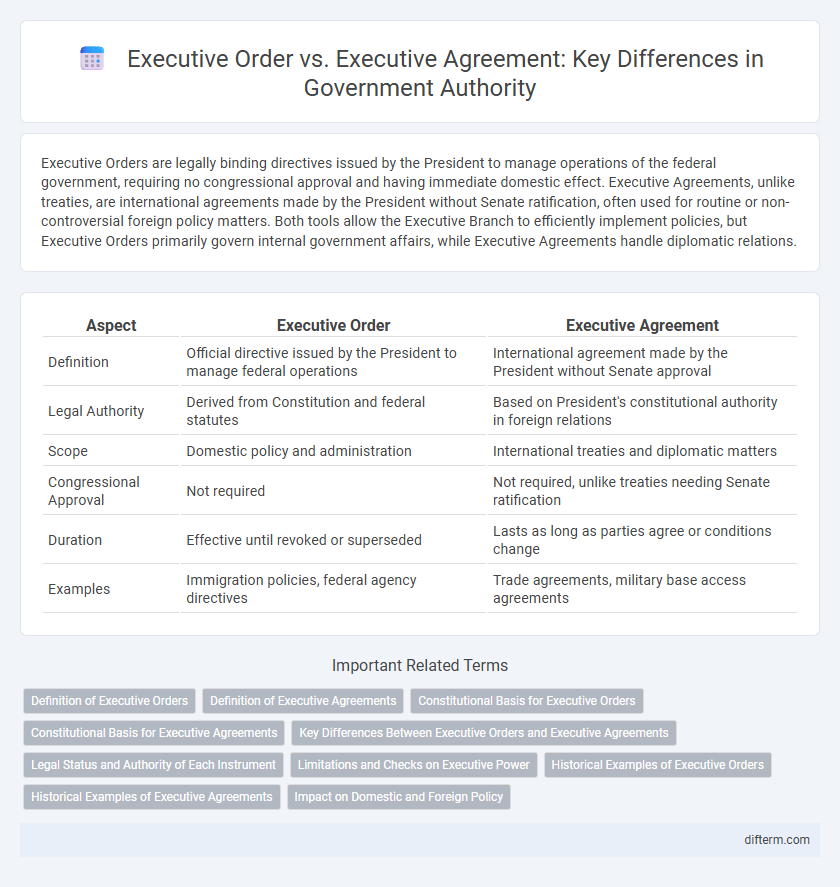Executive Orders are legally binding directives issued by the President to manage operations of the federal government, requiring no congressional approval and having immediate domestic effect. Executive Agreements, unlike treaties, are international agreements made by the President without Senate ratification, often used for routine or non-controversial foreign policy matters. Both tools allow the Executive Branch to efficiently implement policies, but Executive Orders primarily govern internal government affairs, while Executive Agreements handle diplomatic relations.
Table of Comparison
| Aspect | Executive Order | Executive Agreement |
|---|---|---|
| Definition | Official directive issued by the President to manage federal operations | International agreement made by the President without Senate approval |
| Legal Authority | Derived from Constitution and federal statutes | Based on President's constitutional authority in foreign relations |
| Scope | Domestic policy and administration | International treaties and diplomatic matters |
| Congressional Approval | Not required | Not required, unlike treaties needing Senate ratification |
| Duration | Effective until revoked or superseded | Lasts as long as parties agree or conditions change |
| Examples | Immigration policies, federal agency directives | Trade agreements, military base access agreements |
Definition of Executive Orders
Executive Orders are legally binding directives issued by the President of the United States to federal administrative agencies, guiding the execution of existing laws and policies. They derive authority from the Constitution or statutes, enabling the executive branch to manage operations and direct government activities without requiring congressional approval. Unlike Executive Agreements, which are international promises made without Senate ratification, Executive Orders primarily govern internal federal administration.
Definition of Executive Agreements
Executive Agreements are international agreements made by the executive branch of the government without requiring Senate approval, distinguishing them from treaties that need legislative ratification. These agreements typically address routine or technical matters and can be either binding or non-binding depending on the nature of the agreement and the domestic legal framework. Executive Agreements often enable faster and more flexible diplomatic actions, reflecting the executive's authority in foreign policy management.
Constitutional Basis for Executive Orders
Executive orders derive their constitutional basis primarily from Article II, Section 1 of the U.S. Constitution, empowering the President to ensure laws are faithfully executed. These orders carry the force of law within the executive branch and guide federal agencies without requiring Congressional approval. In contrast, executive agreements, often used for foreign policy, rely on the President's inherent treaty-making authority but do not require Senate ratification like formal treaties.
Constitutional Basis for Executive Agreements
Executive Orders derive their authority explicitly from the U.S. Constitution or statutes enacted by Congress, primarily under the President's executive powers. Executive Agreements lack a specific constitutional provision but rely on the President's constitutional power to conduct foreign relations, often supported by existing treaties or congressional authorization. The constitutional basis for Executive Agreements hinges on the President's inherent foreign affairs powers and the practical necessity for timely international agreements without Senate ratification.
Key Differences Between Executive Orders and Executive Agreements
Executive Orders are legally binding directives issued by the President to manage operations of the federal government, while Executive Agreements are international agreements made between the U.S. and foreign governments without Senate approval. Executive Orders primarily affect domestic policy and federal agencies, whereas Executive Agreements shape foreign policy and international relations. The key difference lies in their scope and legal requirements, with Executive Orders rooted in domestic authority and Executive Agreements grounded in diplomatic negotiation.
Legal Status and Authority of Each Instrument
Executive Orders are legally binding directives issued by the President of the United States under the authority granted by the Constitution or statute, carrying the force of law within the federal government. Executive Agreements are international arrangements made by the President without Senate approval, holding the force of an international agreement but typically without the full legal status of a treaty. While Executive Orders govern domestic policy implementation, Executive Agreements primarily manage foreign relations, each backed by distinct legal foundations and scopes of authority.
Limitations and Checks on Executive Power
Executive Orders are subject to judicial review and can be overturned if deemed unconstitutional or exceeding statutory authority, ensuring checks by the judiciary and Congress through funding control and legislative overrides. Executive Agreements, while allowing the President to bypass Senate ratification, remain limited by existing laws and treaties and must not conflict with Congressional statutes, maintaining legislative oversight. Both mechanisms underscore the balance of executive power by operating within legal frameworks and subject to institutional constraints to prevent overreach.
Historical Examples of Executive Orders
Executive Orders have played a pivotal role in shaping U.S. government policy, with notable historical examples including President Abraham Lincoln's Emancipation Proclamation, which declared the freedom of slaves during the Civil War. Franklin D. Roosevelt issued Executive Order 9066, authorizing Japanese American internment during World War II, highlighting the power of executive directives in times of crisis. These orders demonstrate the ability of U.S. Presidents to enact significant policy changes without congressional approval.
Historical Examples of Executive Agreements
Executive Agreements have played significant roles in U.S. foreign policy, such as the 1945 Yalta Agreement between Franklin D. Roosevelt and Winston Churchill, which shaped post-World War II Europe. The 1972 SALT I Agreement, negotiated by President Richard Nixon, helped limit strategic arms during the Cold War without Senate ratification. Unlike Executive Orders, these agreements require presidential negotiation but operate outside the formal treaty process, enabling swift diplomatic action.
Impact on Domestic and Foreign Policy
Executive Orders directly influence domestic policy by directing federal agencies and shaping national priorities without requiring Congressional approval. Executive Agreements primarily affect foreign policy, enabling the President to manage international relations and treaties swiftly without Senate ratification. Both tools streamline governance but differ in legal scope and the balance of power between executive authority and legislative oversight.
Executive Order vs Executive Agreement Infographic

 difterm.com
difterm.com